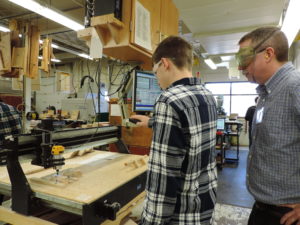
Candor High School Technology Education teacher, Stephen Lindridge, works with a student on March 8 to change a routing program necessary to make new parts for a project collaborated on with OFA.
Candor High School was the final assembly point on March 8 for a project involving approximately 20 students from Candor and Owego Free Academy (OFA). The groups began working independently on a train-building project in the second quarter of the school year, advised by Candor Technical Education teacher, Stephen Lindridge, and OFA’s Technology teacher, Michael Daly.
On March 8, the students gathered to work out tweaks and incorporate their separate pieces into what became an old toy from the past, a steam engine and
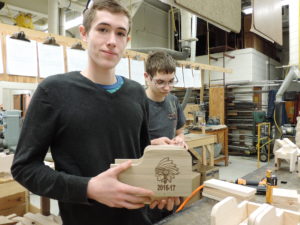
On the left, OFA student Richard Verno shows an etched Indian on the tender of a wooden train, which was made by using a laser engraver at OFA. The selected image was decided upon by students to represent both schools.
tender made of wood with moving parts.
The idea for the project, what Lindridge called the “Legacy Project”, was inspired by a toy truck that Lindridge’s great-grandfather had made and given to his grandmother when she was a young child. Look inside the Tech Ed classroom adjacent to Lindridge’s machining room, and you’ll see about nine years’ worth of wooden toys that line the shelves.
“This is our tenth year of making toys,” Lindridge said, adding, “As capabilities grow, our designs have become more complicated. It’s a great way to prepare the students for the future.”
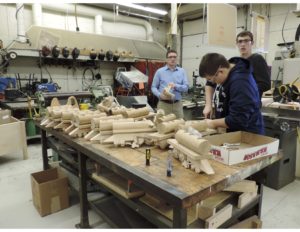
Shown are multiple wooden trains, parts of which were made by students at Candor High School and OFA, and where students worked together to meet a final assembly challenge on March 8.
Initially, the idea was to produce only the steam engine, but then it was decided to add the tender as well, to provide a more difficult, yet realistic challenge for students before they collaborated in the final assembly process.
One added touch, Daly shared, “A laser engraver we have at Owego was used to engrave an Indian on the train.”
The students collaborated to choose the Indian design, which represents both schools.
In a ten week period at their separate
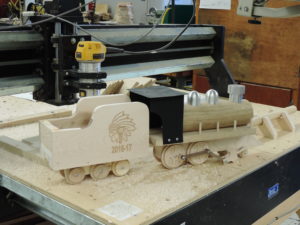
Pictured is a near-completed version of a steam engine and tenders, parts, which were made by students at Candor High School and OFA, and where students worked together to meet a final assembly challenge on March 8.
locations, students learned to put together material lists, gathered specifications and transferred data to computer programs, prepared routing sheets, and operated several tools and machines, including a planer, joiner, table saw, milling machine, drill press, a router, and sanders, among others. One set of parts was originally made to ensure the process they developed worked before they continued on producing multiple quantities.
Candor student, Brittany Williams, who is taking a second year of tech education, worked with the tender construction and was also involved in drafting the lists, specs and routing sheets. When asked for an example of an obstacle faced by the students, Williams replied, “Communication is important for all of the systems.”
A more complicated piece added on the train, the dome, was made using a computer controlled lathe, and another piece, a smokestack, was made using a manual lathe, while a set of fully functional wheels on the train tested students’ decision-making and critical thinking.
A key accomplishment for students was ensuring that the parts made at Candor fit with the parts made in Owego, and vice versa. One particular part had to be tweaked by Lindridge and his students, yet was easily modified using a computer program, and the five parts produced were a quick-turn effort.
Numerous real-world lessons were learned, particularly from communication tools. Throughout the ten-week period when students worked at their individual schools, they utilized a learning management system called “Schoology.” Lindridge described the system as a “Facebook for Education,” and cited that it is an excellent way for students to understand the concept of global manufacturing communications.
The final goal, to assemble all of the trains in one day, allowed each student to take one set home. Daly shared that lumber used for the project was donated by two Tioga County companies.

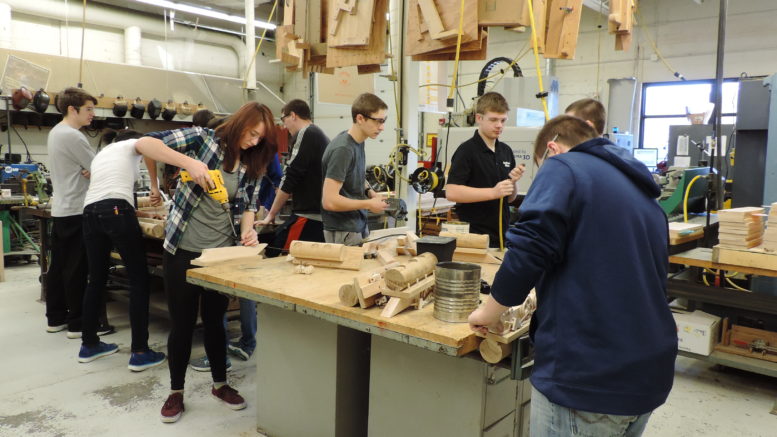

Be the first to comment on "Candor and Owego students experience real-world lessons"